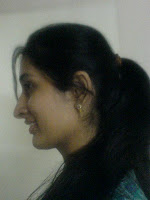 Famous saying goes: sweet rewards come to those who wait. That is so true after fasting for 30 days during the holy month of Ramadan, as Eid is the best thing one could get in return. And as the festivity comes nearer I remember my mother telling me about the sweet rituals of her time. The divine fragrance of attar left many happy moments and sweet memories on Eid day of which she would remain with her always.
Famous saying goes: sweet rewards come to those who wait. That is so true after fasting for 30 days during the holy month of Ramadan, as Eid is the best thing one could get in return. And as the festivity comes nearer I remember my mother telling me about the sweet rituals of her time. The divine fragrance of attar left many happy moments and sweet memories on Eid day of which she would remain with her always. Women pool together in their drawing rooms, an atmosphere of merriment about them as they proceed to apply mehendi in intricate patterns on each other’s hands and feet. The art of applying mehendi is almost a ritual in itself, one that adds an extra slice of mirth to the holy occasion.
However, not many are aware of the way of applying this cosmetic paste in gorgeous and enticing manner. The person in your neighbors, cousins or friends who knows th is art becomes the most vital personality and everybody try to approach her. Luckily or unluckily I also know a lilt bit about applying mhendi and …. same thing happened with me on Channd Raat just after the iftar as the moon was declared I started receiving number of friends and cousin. it was very difficult to manage when everybody was asking and calling “Ayesha” “Ayesha” ”Ayesha yarr its my turn now”..and “I m ur elder cousin so please my turn first” “Ayesha baji main bachi hoon pahlay meari barri” and a lot of stuff like this. Coz everybody was impatient to get their hands decorated in any way. Small girls were very much enthusiastic …and they end in adorning all sides of hands and feet. I noticed the zeal of kids, young’s and old that everybody wants to look dazzling from head to feet by applying gorgeous styles and designs of mhendi.
is art becomes the most vital personality and everybody try to approach her. Luckily or unluckily I also know a lilt bit about applying mhendi and …. same thing happened with me on Channd Raat just after the iftar as the moon was declared I started receiving number of friends and cousin. it was very difficult to manage when everybody was asking and calling “Ayesha” “Ayesha” ”Ayesha yarr its my turn now”..and “I m ur elder cousin so please my turn first” “Ayesha baji main bachi hoon pahlay meari barri” and a lot of stuff like this. Coz everybody was impatient to get their hands decorated in any way. Small girls were very much enthusiastic …and they end in adorning all sides of hands and feet. I noticed the zeal of kids, young’s and old that everybody wants to look dazzling from head to feet by applying gorgeous styles and designs of mhendi.
Designs vary from country to country. Indian mehendi art incorporates fine lines, with lace-like and floral patterns, while Moroccan and African designs are thicker, bolder, and with geometric angles. Henna is also simply applied in a thick layer on the palms and soles of feet, as is sometimes practiced in our own country.
Asides its aesthetic element, henna is believed to hold special medicinal value. It is said to soothe dry skin, heal certain skin diseases, and reduce swelling. Even beverages are concocted out of it for stomach cramps and headaches.
Undoubtedly, henna is more than just a cosmetic paste, its cultural and traditional worth making it a part and parcel of many festivals. In our country , Pakistan, heena adds an extra celebration in wedding ceremonies. Girls and friends of bride apply beautiful designs of heena on bride’s hands and sing beautifull songs of mehndi like “Mehndi say likh do ri hatoon pay sakhyoo maray sanwarya ka namm” meaning thereby is (write the name on my palms of my beloved with mehndi)
From weddings and engagements to religious occasions, all remain more or less incomplete without it. With only a few days left before Eid, one can already visualise the halwa and paratha laden table and hear the merriment of female relatives and friends alike, assembled together the night before Eid as they usher in the celebrations with joyful anticipation, and with intricately designed mehendi on their hands.





2 Comments:
posy
its nyc..aisha can we chat?
Post a Comment
Subscribe to Post Comments [Atom]
<< Home